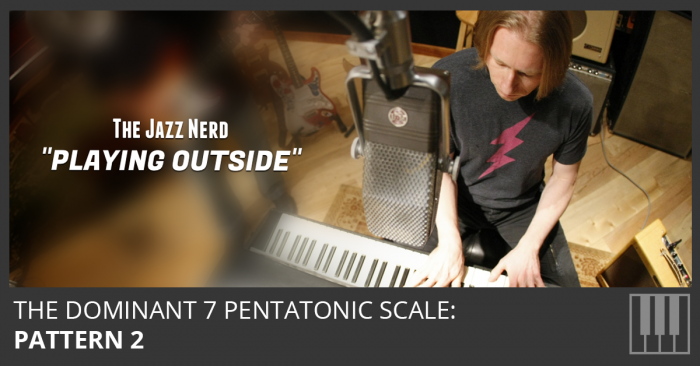This dominant 7 pentatonic pattern gets tougher again. It has four notes in C and four notes in D flat but they are all spread throughout the bar. Again, this pattern helps you to get comfortable transposing quickly. And all of these patterns … [Read more...]
Playing Outside: The Dominant 7 Pentatonic Scale Pattern 4
This pattern should be easier than the previous dominant 7 scale pattern. The transposition doesn't split the bar so you only have to think about transposing once during the full pattern. The rewarding function of this pattern is that you can use … [Read more...]
Playing Outside: The Dominant 7 Pentatonic Scale Pattern 3
This dominant 7 pentatonic pattern is similar to the previous pattern. It still moves up a half step for a total of 2 notes in an eight note pattern. But this time, the transposed notes are the fifth and eighth notes in the sequence. This means that … [Read more...]
Playing Outside: The Dominant 7 Pentatonic Scale Pattern 2
If Dominant 7 Pentatonic Scale Pattern 2 seemed easy to you, I guarantee you'll find this next one more challenging. Last time, we took a four-note pattern and transposed it up a half step for the second half of the bar. This time, we're using a … [Read more...]
Playing Outside: The Dominant 7 Pentatonic Scale Pattern 1
John Coltrane loved the Dominant 7 Pentatonic Scale. During the 60s, Trane (and other avant-garde musicians like Ornette Coleman) created a unique and dissonant style of "playing outside" the chord changes. Often, they would play a half-step … [Read more...]
Confusing Music Theory Fundamentals And Cliche
Wanna hear something provocative? Check out this quote from an old issue of keyboard magazine. "On this experimental record, I've been trying to explore more jazz harmonies. The thing is -- and I'm gonna piss off a lot of people here -- the II-V-I … [Read more...]
Top Music Theory Articles for 2006
Looking back over 2006 I can say that I learned a lot. And it seems that I taught a lot too! These music theory articles should keep you busy over the holiday break. The Rules and Principles of Counterpoint Deceptive Cadences Advice To … [Read more...]
Piano Voicings Part 6: Clusters
Clusters usually span no more than a fifth and include both half steps and whole steps. Clusters increase tension and when preceding open chords can make them seem wider. Clusters also sound good when rolled. … [Read more...]
Piano Voicings Part 5: Kenny Barron Voicings
Kenny Barron voicings are composed of two perfect fifths in each hand and separated by a minor second: This symmetrical voicing can also be played with a major second between the two hands creating a completely different chord quality. Notice … [Read more...]
Piano Voicings Part 4: Upper Structure Chords
Upper structure chords consist of a triad-or triad inversions-over a tritone. Here's a chart of common upper structures: … [Read more...]

